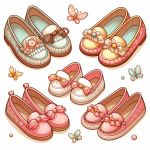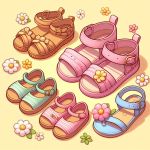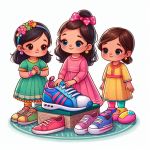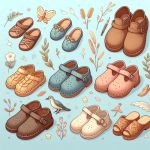Explanation of Shoe Sizes:
The History of Children’s Shoes in EuropeThe history of children's shoes in Europe is deeply intertwined with the development of fashion, craftsmanship, and social structures. Over the centuries, children's footwear has evolved from simple, functional shoes to fashionable accessories that serve not only to protect the feet but also reflect social status. The story of children's shoes can be divided into several distinct eras, each marked by changes in design, materials, and the roles shoes played in children's lives. Early History and the Middle Ages: Function and ProtectionIn ancient times and throughout the Middle Ages, shoes in Europe were primarily functional, providing protection for the feet. Children often wore the same shoes as adults, only in smaller sizes. During this period, shoes were made from simple materials such as leather, cloth, or wood, and were typically hand-crafted. While shoes were essential for protection, they also indicated social standing, with wealthier individuals having access to higher-quality materials and more decorative footwear. During the Middle Ages, the first distinctions between adult and children's shoes began to emerge. While most children wore shoes that were more practical and durable, some wealthier families had shoes made of finer materials such as leather and decorated with adornments like buckles and laces. However, many children still went barefoot, especially in rural areas, or wore rudimentary footwear. The Renaissance and Baroque Periods: The Rise of IndividualityThe Renaissance and Baroque periods in the 16th and 17th centuries brought about a shift in European society, and children's fashion began to reflect broader social changes. Wealthier families adopted more ornate, sophisticated styles for their children, often mirroring the fashion of adults. The footwear of the time for children began to feature decorative elements such as ribbons, buckles, and embroidered fabrics, especially among the nobility. For the upper classes, children’s shoes became an important status symbol. The shoes were made from luxurious materials such as velvet, silk, and fine leather, often adorned with lace or gold accents. Meanwhile, for the lower classes, children’s shoes remained simple and functional, focusing on durability rather than style. This period marked a growing emphasis on how children were dressed, with shoes being a significant part of the overall attire, reflecting a burgeoning sense of childhood as a distinct stage of life. The 18th Century: The Importance of Children's FashionThe 18th century saw an even greater focus on children’s appearance and social roles, particularly among the wealthier classes. During this time, the idea of childhood as a distinct and important phase of life gained more recognition, and with it, the desire to dress children in a manner that reflected both their innocence and social position. Children’s shoes became more elaborate and decorative, often including elements such as small heels, ribbons, and intricate stitching. They were crafted from materials like leather, satin, and brocade, and were intended to match the luxury of the children's clothing. While the shoes of the nobility were often quite fashionable, those worn by poorer children remained simpler and more utilitarian. Nonetheless, it was during this time that children's shoes began to take on a more personalized and fashionable role in European society. The 19th Century: The Industrial Revolution and Mass ProductionThe 19th century marked a significant turning point in the history of children’s shoes in Europe. With the advent of the Industrial Revolution, the production of shoes became mechanized, allowing for mass production. Shoes were now made in larger quantities and at lower costs, making them more accessible to a broader segment of the population. This shift helped ensure that more children, even in lower-income families, had access to proper footwear. In the late 19th century, children's shoes began to reflect the prevailing adult fashions, with more intricate designs, various colors, and decorative features becoming popular. However, the importance of practicality remained, particularly for rural children, who still often wore simpler, more durable shoes. The introduction of new materials, such as rubber for soles, marked a technological advancement in children’s footwear, increasing both comfort and longevity. The 20th Century: Changing Styles and SpecializationThe 20th century brought significant changes to children's footwear, particularly in the post-World War II period, when the role of children’s fashion became more pronounced. Shoes were no longer just functional items but also part of a growing market for children's clothing and accessories. In the mid-20th century, children’s shoes became more specialized, with companies designing footwear specifically for different age groups and activities. This was also a time when branded shoes began to appear, with companies like Nike and Converse creating styles that appealed to younger generations. As the century progressed, children's shoes became an important part of personal expression and fashion. The increasing availability of mass-produced shoes meant that children of all classes could access a variety of styles, from sturdy boots for outdoor play to elegant shoes for special occasions. In the 1960s and 1970s, brightly colored shoes, sneakers with logos, and shoes designed to match specific children's clothing trends became commonplace, signifying the growing intersection between fashion and childhood. Conclusion: From Function to FashionThe history of children’s shoes in Europe reflects broader shifts in society, from a focus on practicality and protection to a growing emphasis on fashion and personal expression. Over the centuries, shoes evolved from simple and functional items to intricate fashion statements that cater not only to the practical needs of children but also to their desire for individuality and style. Today, children's shoes are an integral part of the fashion industry, with a wide range of options available that balance comfort, durability, and aesthetics. As we look to the future, it is likely that children’s shoes will continue to evolve, incorporating new materials, technologies, and trends that reflect both the changing world and the needs of the next generation.  |















